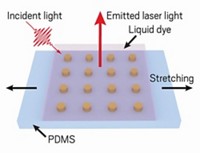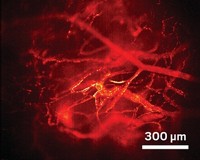Advertisement
Grab your lab coat. Let's get started
Welcome!
Welcome!
Create an account below to get 6 C&EN articles per month, receive newsletters and more - all free.
It seems this is your first time logging in online. Please enter the following information to continue.
As an ACS member you automatically get access to this site. All we need is few more details to create your reading experience.
Not you? Sign in with a different account.
Not you? Sign in with a different account.
ERROR 1
ERROR 1
ERROR 2
ERROR 2
ERROR 2
ERROR 2
ERROR 2
Password and Confirm password must match.
If you have an ACS member number, please enter it here so we can link this account to your membership. (optional)
ERROR 2
ACS values your privacy. By submitting your information, you are gaining access to C&EN and subscribing to our weekly newsletter. We use the information you provide to make your reading experience better, and we will never sell your data to third party members.
Imaging
New dyes improve bioimaging in mice
Xanthene-based dye fluoresces brightly at 1,200 nm
by Celia Henry Arnaud
October 23, 2021
| A version of this story appeared in
Volume 99, Issue 39

Fluorescent dyes with emission wavelengths in the near-infrared region (NIR) can enable tissue imaging from deeper within the sample than dyes with shorter emission wavelengths. But dyes with emission wavelengths in the so-called NIR-II region, 1,000–1,700 nm, are often not as bright as researchers would like. Wen Shi and coworkers at the Chinese Academy of Sciences now report a family of xanthene-based dyes that fluoresce strongly in the NIR-II (J. Am. Chem. Soc. 2021, DOI: 10.1021/jacs.1c07711). These dyes, which the researchers call VIXs, have a xanthene core that is modified with para-substituted styryls. VIXs with nitrogen-bearing styryls fluoresce at longer wavelengths than VIXs with oxygen-bearing styryls. VIX-4, which fluoresces at wavelengths longer than 1,200 nm, is modified with julolidinestyryl. To demonstrate the dyes’ performance, the researchers used VIX-4 encapsulated in liposomes to image blood circulation in mice. They injected VIX-4 into the tail vein of mice and were able to watch the circulatory system light up as the dye progressed through the body. The dye was bright enough that clear images could be obtained with exposure times as low as 5 ms. The researchers were able to calculate blood-flow velocities and achieved spatial resolution that was good enough to differentiate between closely spaced femoral arteries and veins.





Join the conversation
Contact the reporter
Submit a Letter to the Editor for publication
Engage with us on Twitter